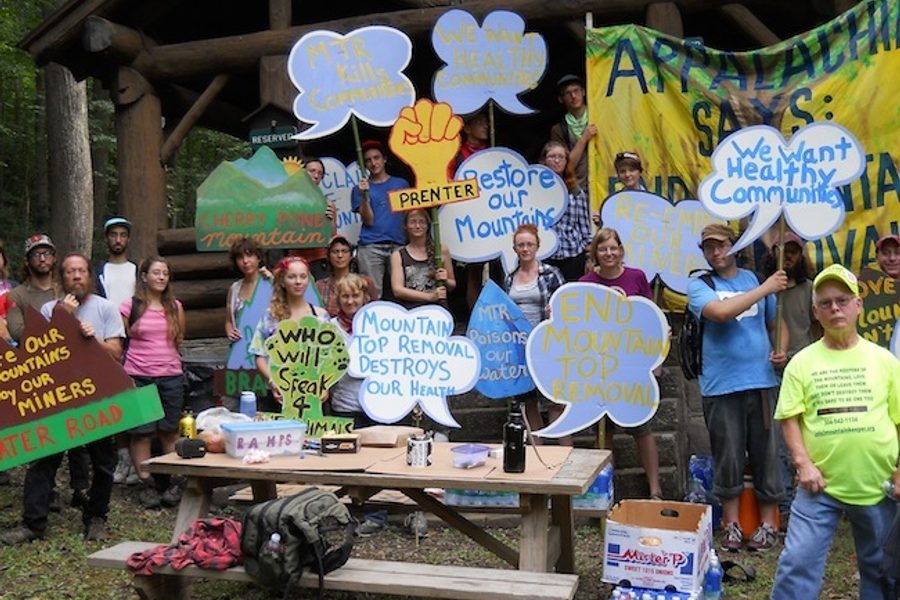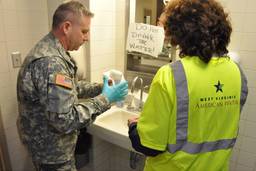
A direct action to close down a West Virginia mountaintop removal site — and the response to it — has escalated the struggle around coal mining in southern Appalachia.
In late July, Radical Action for Mountain People’s Survival (RAMPS) held a training for 100 activists on a sheep farm in Nicholas County in preparation for what they called “a mass mountaintop removal (MTR) mine site walk-on.” The aim was to shut down operations for as long as they could and raise awareness of MTR, in which mountain ridges are dynamited to get at the coal seams beneath, with the resulting rocks and soil dumped in valleys below.
So far more than 500 ridges have been destroyed and more than 2,000 miles of streams have been buried. Several scientific, peer-reviewed studies over the past few years show a significant increase in both cancer and birth defects among residents of communities near MTR sites as compared to similar communities not near such sites, although no direct connection has yet been proven.
On July 28, RAMPS organizers drove the activists to their destination (which they hadn’t been told of beforehand): the Hobet 45 surface mine in Lincoln County, the largest MTR site in Appalachia. Forty-five people ran from a caravan of cars and scattered over the site — which was overseen by one unarmed security guard — dropping banners, climbing trees and locking down equipment.
The largest action on an MTR site to date resulted in 20 arrests, with the other activists allowed to walk off after heeding orders from police. However, police did not allow the protesters’ support vehicles to pick them up at the site, forcing them to walk through a gauntlet of angry miners for four hours. The locals yelled and revved their vehicles close to the line of activists, one of who described the encounter as the most hostility he’d experienced in 40 years of activism.
Hobet 45 received a highly contested permit from the Obama administration in 2010. Mine owner Patriot Coal recently filed for bankruptcy, and the future of the United Mine Workers-affiliated workforce is unclear. The number of miners in West Virginia has plummeted due to mechanization and the fact that surface mines require fewer workers than deep mines.
Those arrested were charged with trespassing and interfering — both misdemeanors — and slapped with bail of $25,000 each. RAMPS’ jail support committee charged that Dustin Steele, a local RAMPS organizer, was badly beaten while in custody. Nineteen activists ultimately took a plea deal of $500 in fines and one year of unsupervised probation, after spending as long as 10 days in jail, while Steele, who was the only activist to have paid bail, said he also plans to take the deal. However, he reiterated his commitment to ending surface mining.
In an interview before the action, Steele said coal must be replaced as an energy source.
“I feel like there has to be a transition point but it has to start with mountaintop removal being over tomorrow, “ Steele said. “We’re to the point where if we don’t start addressing the problems with our environment, it’s going to be too big for human beings to fix ourselves, so we have to get away from coal mining as soon as possible.”
As a diversionary measure from the action on Hobet 45, organizers had called for a rally at a park in Charleston, 90 minutes away. About 25 activists gathered with hand-painted signs featuring the names of destroyed mountains, highlighting potential health impacts of MTR, or calling for the re-employment of miners whose job sites are shut down.
They were greeted by 100 supporters of coal — miners and other locals and family members. They did a lot of yelling, but many of them also engaged in earnest dialogue with MTR opponents, at least with the ones from West Virginia. Most outsiders they dismissed as just trying to take their jobs away.
Billie Epperheart held a sign that read, “My hero wears orange [miners’] stripes. Mess with a miner – deal with his wife.” She said the RAMPS website contributes to polarization.
“Why not have on the website, ‘Open the lines of communication; any idea is welcome,’ not ‘Join us in shuttin’ down a mountain?!’” she asked. “I mean, seriously, that just breeds violence and anger. I literally feel like I’m fighting for my life and my children. So when I go to bed at night, that’s what I go to sleep with.”
Chad, a local MTR opponent who declined to give his last name, acknowledged Epperheart’s concerns while trying to find common ground, such as the desire of all parents to raise their kids in a safe, clean environment — something that Chad argued was made impossible by MTR mining.
Many of the pro-coal protesters held aloft Friends of Coal signs, provided by the mine owners’ association of the same name. One pro-coal protester recited a litany of all the workers who depend on coal production: the miners, the bulldozer operators, the loggers who clear the trees, the waitresses at restaurants frequented by those workers, etc.
In response, an MTR opponent rattled off the improvements that could come from promoting renewable energy in the region. (A feasibility study of wind turbines atop Coal River Mountain concluded wind power would be a viable option.) With coal production in Appalachia declining regardless of how it’s mined, MTR opponents say it’s time to start considering other options.
In the meantime, coal-laden barges, trains and trucks leave the coal fields daily. Dr. Dan Doyle, a family physician who works in the area, likened the coal companies’ rush to mine every coal seam to someone on a 15-minute shopping spree at a supermarket.
“They’re on the clock, and they’re going to get everything they can until the whistle blows,” Doyle said. “The Friends of Coal campaign is to do everything possible to extend that by a few years so that they can cram as much coal wealth and energy wealth into their carts before it comes to a stop.”





